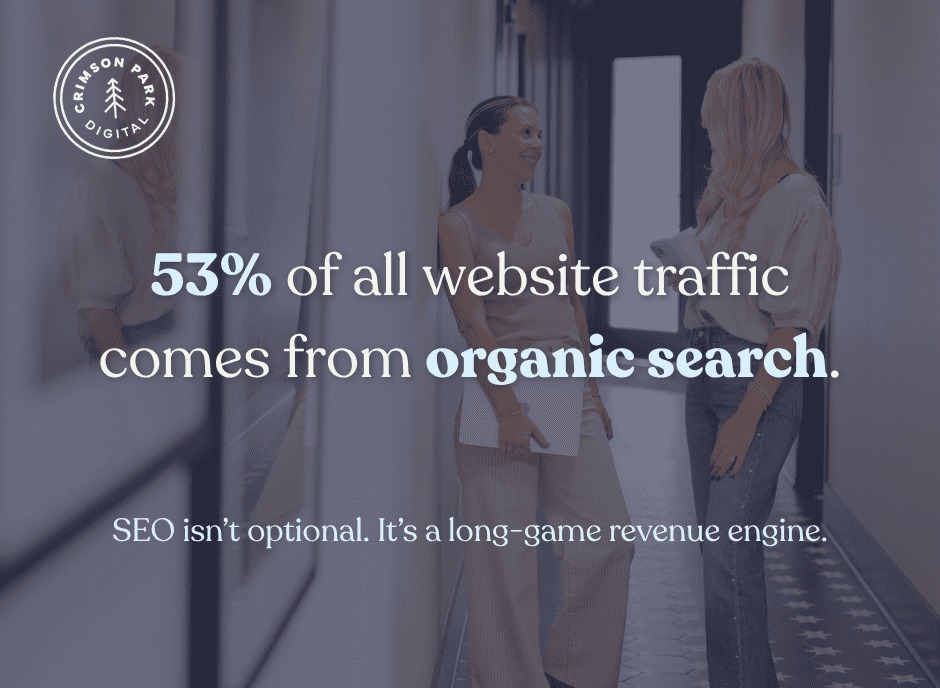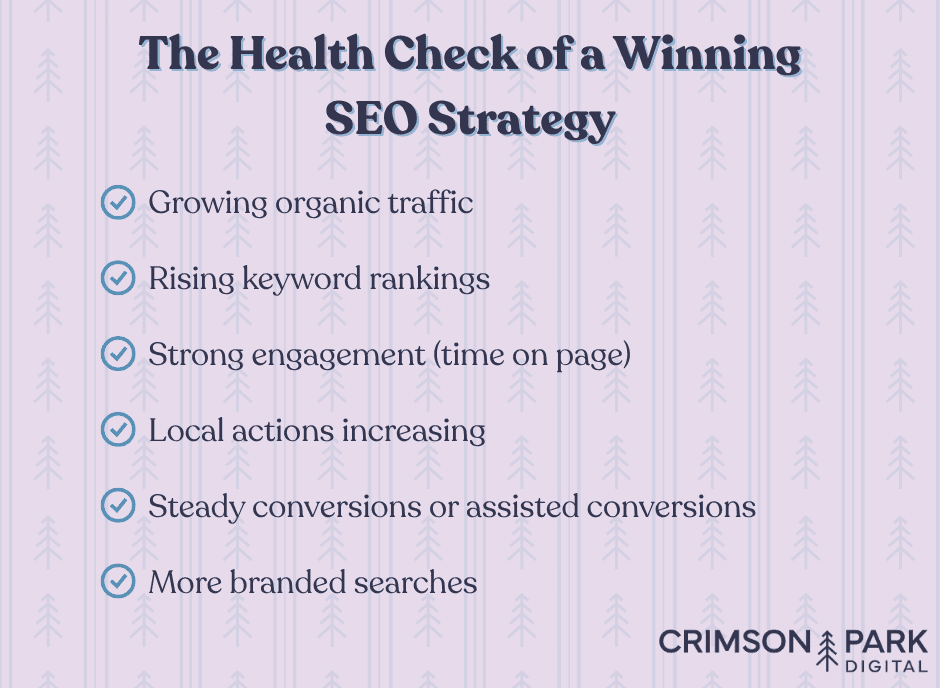Here’s the upside. Once you understand which SEO and GEO (generative engine optimization) metrics actually matter, you stop feeling like you’re guessing at what’s working. You get clarity. You get momentum. You get to brag in meetings. And most importantly, you get a website that attracts the right people without having to scream into the digital void.
At Crimson Park Digital, we specialize in search marketing, reading the signals that really matter. Consider this your behind-the-scenes tour of how to tell if your SEO strategy is winning, wobbling, or ready for a refresh.
Why SEO Impact Metrics Matter More Than Ever
SEO used to be simpler. Google ranked your content, people clicked, and you tracked your progress with a handful of familiar metrics. Now? Search journeys are bouncing between Google, social media, geo-driven queries, AI-powered answers, and chat-style engines like Gemini, ChatGPT, and Perplexity.

That means the old “check your rankings and call it a day” approach doesn’t cut it anymore.
Impact metrics give you the truth behind your visibility. They show whether your content is getting discovered on traditional search and AI-driven platforms, whether users actually like what they find, and whether your website supports that experience or sends people running for the exit.
With the right metrics in your corner, you get:
- Clear insight into what’s working and what should be kicked to the curb
- The ability to spot early signals before performance drops
- More purposeful spending since you know which levers drive revenue
- A roadmap for building authority across both AI search and classic search
And let’s be honest. Metrics make strategy feel less like guesswork and more like something you can confidently defend in your next leadership meeting.
The Core SEO Metrics Every Business Should Actually Care About
There are hundreds of potential metrics you could track, but only a handful consistently tell the real story. These are the heavy hitters that reveal whether your SEO and content are doing their job.
1. Organic Traffic
Organic traffic is still the heartbeat of SEO performance. When people find you through unpaid search, it means your content is aligned with what they want. If organic traffic climbs, your visibility is improving. If it drops, it’s a sign to look closer at rankings, content relevance, or technical issues.
The trick is not to obsess over daily fluctuations. Zoom out. Patterns over weeks and months help you see the bigger picture.
2. Search Visibility and Keyword Performance
Rankings matter, but not in the old “What’s our position for this one keyword?” kind of way. Modern rankings are more about visibility patterns:
- How many keywords are moving upward
- Whether high-intent phrases are improving
- How well you’re performing for long-tail, conversational, and question-driven queries
Since AI engines borrow heavily from top-ranking search content, improving traditional rankings often supports GEO visibility, too.
3. Engagement Metrics: Bounce Rate and Dwell Time
If users show up and leave instantly, something’s off. If they stick around, scroll, and explore, you’re in good shape.
Bounce rate hints at relevance. Dwell time hints at quality and clarity.
You don’t need to aim for perfection. You just need movement in the right direction.
4. Conversions and Assisted Conversions
Traffic is lovely, but leads and revenue keep the lights on. Tracking conversions from organic search (and the paths people take before converting) helps you understand how SEO contributes to business outcomes, not just pageviews.
Sometimes organic doesn’t convert on the first touch, but it does assist. That’s a big win too.
5. ROI
ROI ties your SEO investment to real outcomes. It’s not instant, but once it kicks in, SEO tends to become one of the most cost-effective channels you have. Blending ROI with long-term visibility trends is where things get exciting.

The New Frontier: AI-Driven Search and GEO Metrics
Generative engines aren’t just a trend. They’re here to stay, reshaping how users discover brands. And that means your KPIs need an upgrade.
Generative engine optimization looks at how your content appears within AI responses, conversational results, and synthesized answers. The challenge is simple. AI models often pull from search results, but not always in ways you can measure traditionally.
Some signals to watch:
- Whether your content is ranking for question-style queries
- Whether your titles and headers mirror natural language queries people ask
- Whether your brand or content themes appear in zero-click environments
- Whether your existing search visibility improves in parallel with AI search changes
You won’t get a dashboard with a bright button that says “Congrats, the robots love you,” but you’ll see more site visits from AI-driven referrers, more impressions for long-tail phrases, and stronger performance on topically relevant clusters. That’s where digital marketing agencies (like CPD) tap into the deeper patterns most companies don’t have time to analyze on their own.
Technical SEO Metrics That Quietly Shape Your Search Success
Technical SEO isn’t glamorous, but it’s a huge part of proving impact. When your site is fast, accessible, mobile-friendly, and easy for search engines to crawl, every other effort works better.
Metrics worth watching include:
- Page speed and load time
- Mobile responsiveness
- Core Web Vitals
- HTTPS and security
- Indexation health
- Crawl errors
Think of technical SEO as the engine under the hood. You can have the nicest content in the world, but if your engine sputters, the car’s not going anywhere.
Local SEO and Brand Authority Metrics
If your business caters to local audiences, this section becomes mission-critical. Visibility in your city or service area depends on strong local signals.
Monitor:
- Google Business Profile views
- Search queries leading to your profile
- Customer actions (calls, directions, website clicks)
- Local keyword movement
- Review volume and sentiment
Local SEO is one of the fastest ways to build brand trust and authority since people searching locally tend to have higher purchase intent.
How to Tell if Your SEO Strategy Is Working As Intended
A good SEO strategy isn’t only about climbing rankings. It’s about movement, momentum, and relevance.
You’ll know things are working when:
- Organic traffic shows sustainable growth over months
- Higher-quality keywords start moving upward
- Users spend more time on your site
- Content earns more impressions for long-tail, natural-language phrases
- Local search actions increase
- Conversions or assisted conversions grow
- You see more branded search trends
SEO is a long game, but these signals show that your strategy is building real equity.
When to Pivot Your Organic Search Strategy
Even strong strategies need adjustments. Pivot when you see:
- Plateaued organic traffic
- Declining rankings for high-value pages
- Repeated dips after algorithm updates
- Slower conversion performance
- New competitors outranking you for your core topics
- A shift in user behavior (think AI-driven search changes)
Pivots don’t mean starting over. They usually mean tightening your focus, refreshing content, addressing technical issues, or rethinking keyword intent.
Turning Metrics Into Action
Here’s the secret. Metrics don’t matter unless you do something with them.
Some ways to turn insights into growth include:
- Refreshing content that slips in rankings
- Re-optimizing pages with high impressions but low clicks
- Improving UX on high-traffic, low-engagement pages
- Strengthening internal links around your core themes
- Expanding topic clusters for stronger topical authority
- Updating metadata to align with new search behaviors
This is where agencies shine because interpreting data and responding quickly is a full-time job. Most businesses lack the bandwidth to decode the patterns that lead to those big wins.
Building a SEO Measurement Strategy That Actually Scales
A sustainable SEO and GEO measurement strategy isn’t about drowning in data. It’s about choosing the metrics that tie back to real business goals and tracking them consistently enough to understand what’s actually driving growth. When your visibility increases, your search presence stays steady through algorithm shifts, and users keep engaging with your content, you know you’re moving in the right direction.

Search is evolving faster than ever, so the brands that win are those that adapt, stay curious, and treat SEO as an ongoing system instead of a one-time task. The good news is you don’t have to navigate that complexity alone.
If you want a partner who understands both traditional SEO and the new world of AI-driven search, Crimson Park Digital can help you build a measurement strategy that works, evolves, and actually supports your business goals. Let’s make your visibility stronger, your content smarter, and your results easier to prove. Reach out today!
